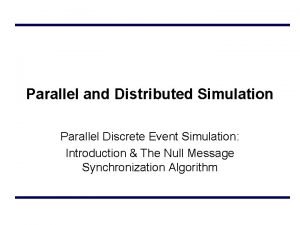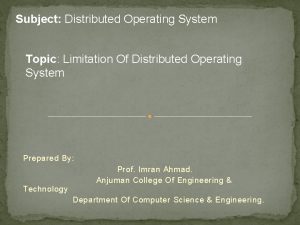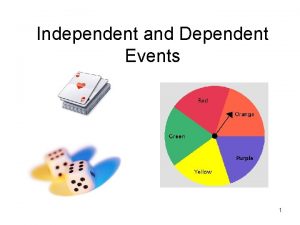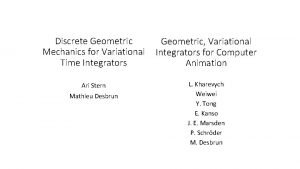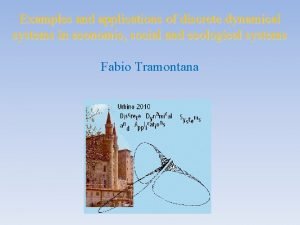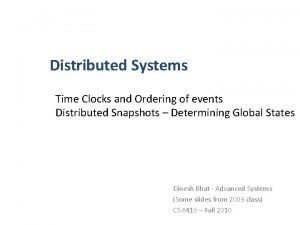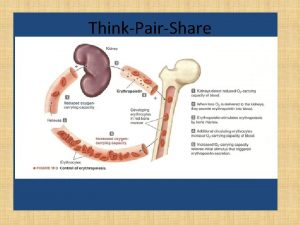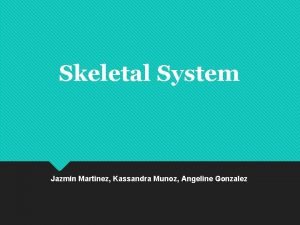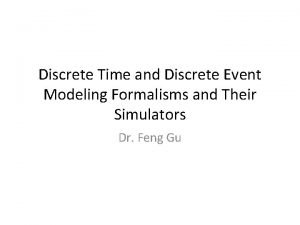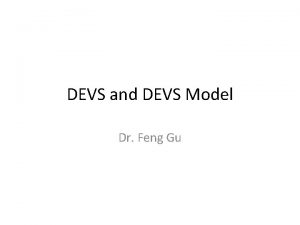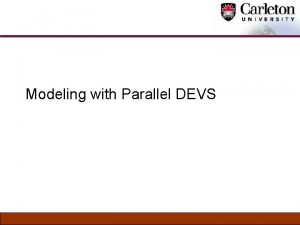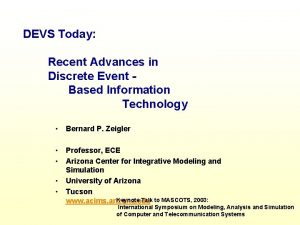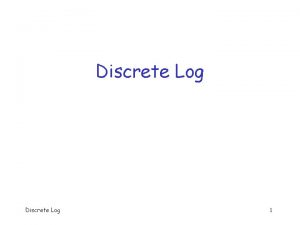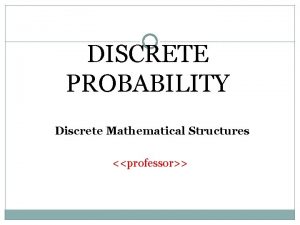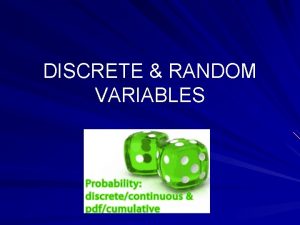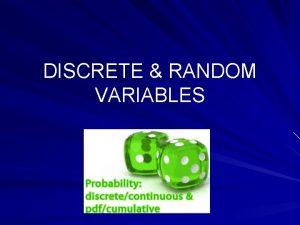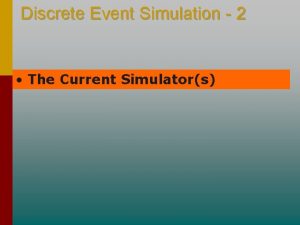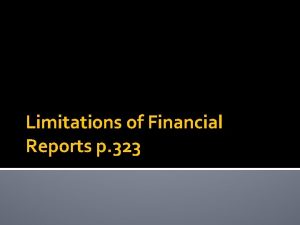Discrete EVent Systems specificaton DEVS Other Formalisms Limitations




















- Slides: 20

Discrete EVent Systems specificaton DEVS Other Formalisms. Limitations. DEVS.

Review System dynamics Paradigms System Dynamics : A sequence of state transitions Model : A set of rules for a state transition X System S Y CVDS DTDS DEDS DDS x(t)

Review CFSM for the ping-pong example player_A player_B Ball_B D A Ball_A Ball_B Ball_A D Ball_A A Ball_B Problem : player_A output: Ball_A. Transition ? Ball_A CFSM A_A, B_D A_D, B_A Ball_B Player_A : X S S XA = {Ball_A} { } : internal event Ball_A A_A A_D A_A feedback A_D

Limitation of expressive power in FSM Ex) ping-pong game player_A Receiving state player_A Ball_B A_A A_D Ball_B R_B Ball_A A_A Ball_B replace A_A ? R_B Ball_A A_A Ball_B A_D Ball_A – (i) what if “attack” takes 2 steps : one state generating an output and the other state with no output. State independent of any inputs. – (ii) what if we want to specify time to be spent for state A or D – A takes 0. 1 sec. – D takes ? sec. • input event -> State transition • time modeling -> Infinity • No semantics for such sojourn time specification: logical time models.

Solution: DEVS (Discrete EVent System specification) formalism Internal transition & time advance function (defined): – introducing internal transition function int : S S – introducing time advance function ta : S R+0, S s, e X Y A DEVS Model is one that can represent any system that produces a finite number of state transitions in a finite amount of time.

DEVS Modeling & Simulation Framework DEVS = Discrete EVent System specification Provides a sound formal M&S framework Supports a full range of dynamic system representation capability Supports hierarchical & modular model development (Bernard P. Zeigler, 1976/84/90/00)

DEVS Formalism Discrete-Event formalism: time advances using a continuous time base Basic models can be coupled to build complex systems Abstract simulation mechanism. Atomic Models: M = < X, S, Y, int, ext, , ta > Coupled Models: CM = < X, Y, D, {Mi}, {Ii}, {Zij}, select >

The DEVS Framework for M&S Separates Modeling from Simulation Derived from General Systems Theory (GST) – Includes Continuous and Discrete Time Systems Provides well defined coupling of components Supports – Hierarchical construction – Stand-alone testing – Repository reuse Enables provably correct, efficient, event-based, and distributed simulation.

Formalism transformations Continuous Discrete Formalism Space and Formalism Transformation Graph (FTG) DEVS as a common denominator for Multi-formalism Hybrid Systems Modelling Hans Vangheluwe School of Computer Science, Mc. Gill University

DEVS Atomic models Atomic DEVS = < S , X , Y , int , ext , , ta > – X : external input event set – Y : external output event set – S : state set – int: internal transition function – ext : external transition function – : output function – ta : time advance function S s, e X Y

DEVS Atomic models

DEVS Atomic models X S ta e Y 0 → → ta X = Set of input values Y = Set of output values S = Set of possible states d int : S S = Internal state transition function d ext : S 0+ X S = External state transition function l : S Y = Output function + ta : S 0 = Time advance function (e = Elapsed time since last state transition) s’ = int (s) s’ = ext (s, e, x)

DEVS Atomic internal transition s S s’ (4) s’ s ta e y 0 → → ta (5) (3) (1) Y (2) DEVS Atomic Model components: X = Set of input values Y = Set of output values S = Set of possible states d int : S S = Internal state transition function d ext : S 0+ X S = External state transition function l : S Y = Output function + ta : S 0 = Time advance function (e = Elapsed time since last state transition) s’ = int (s)

DEVS Atomic external transition X s’ x (1) (2) e s S s’ (3) ta e 0 → → ta (4) DEVS Atomic Model components: X = Set of input values Y = Set of output values S = Set of possible states d int : S S = Internal state transition function d ext : S 0+ X S = External state transition function l : S Y = Output function + ta : S 0 = Time advance function (e = Elapsed time since last state transition) s’ = ext (s, e, x)

Total State Set Q = {q=(s, e) | s S , 0 e ta(s)} e: elapsed time s: current state ext : X * Q S s’ = ext(s, q) s’ = new state – Alternative notation – Not mandatory

Atomic model dynamics External Event Transition Function: transforms a state and an input event into another state – (e. g. , when receiving a faulty device put it into the queue to await its turn for repair. ) Internal Event Transition Function: transforms a state into another state after a time has elapsed – (e. g. , given that there are 10 parts available and a broken part requiring 7 of them, after fixing the broken part, 3 parts will remain. ) Time Advance Function that maps a state into a duration – (e. g. , how long it will take to a device once processing has started. ) Output Function that maps a state into an output – (e. g. , when the number of parts available falls below a minimum number, issue an order to restock the part. )

Ping-Pong Atomic model example AMplayer_A =< X, Y, S, int , ext , , ta > – X = {Ball_B} – Y = {Ball_A} – S = {A, D} – int (A) = D – ext (Ball_B, D) = A – ta(A) = think_time – ta(D) = infinity – (A) = Ball_A Ball_B A D Ball_B Ball_A

Atomic model example (pseudocode) • compact expressions Processing Server Atomic model: P State variables: sigma=inf; phase={passive}; job-id=none; Parameters: processing-time = 5; _____________________ ext (s, e, x) { case port in: case phase passive: save job-id hold in busy during processing-time busy: continue otherwise: error } _____________________ int (s) { case phase busy: passivate passive: /* never happens */ } _____________________ (s) { send job-id to the out port } • Fixed Delay • No queueing • No preemption

Dynamic behavior of DEVS models out in M output y 1= (s 2) t input x 1 x 2 t s 2 s 1 s 0 S s 2= ext(s 0, e, x 1) s 1= int(s 2) s 0 Usually adopted convention for sigma: “remaining time” t e sigma=ta(s) ta(s 2) ta(s 1) ta(s 0) t 0 t 1 t 2 t 3 t t 2 t 3 sigma e

Atomic model example Processing Server with queueing Note: Usually sigma, e and phase are not explicitly annotated in function arguments. They are implicitly assumed to be always available. In this context, ta(s)=sigma is assumed to be executed at the end of every ext and int
 Brett laming
Brett laming Parallel discrete event simulation
Parallel discrete event simulation Limitations of distributed system
Limitations of distributed system Sentinel event
Sentinel event Worksheet 12-8 compound probability
Worksheet 12-8 compound probability Independent or dependent
Independent or dependent Dependent events examples
Dependent events examples Swot for event planning
Swot for event planning Bridge breaks in central java the text tells us about
Bridge breaks in central java the text tells us about Newsworthy event (s); background event (s); sources
Newsworthy event (s); background event (s); sources Discrete systems integrators
Discrete systems integrators Accelarationist
Accelarationist Types of position
Types of position Event sustainability management systems
Event sustainability management systems Leslie lamport time clocks
Leslie lamport time clocks Free enterprise and other economic systems
Free enterprise and other economic systems Circulatory system interactions with other systems
Circulatory system interactions with other systems Circulatory system interactions with other systems
Circulatory system interactions with other systems Integumentary interactions with other systems
Integumentary interactions with other systems Skeletal interactions with other systems
Skeletal interactions with other systems Nervous interactions with other systems
Nervous interactions with other systems

